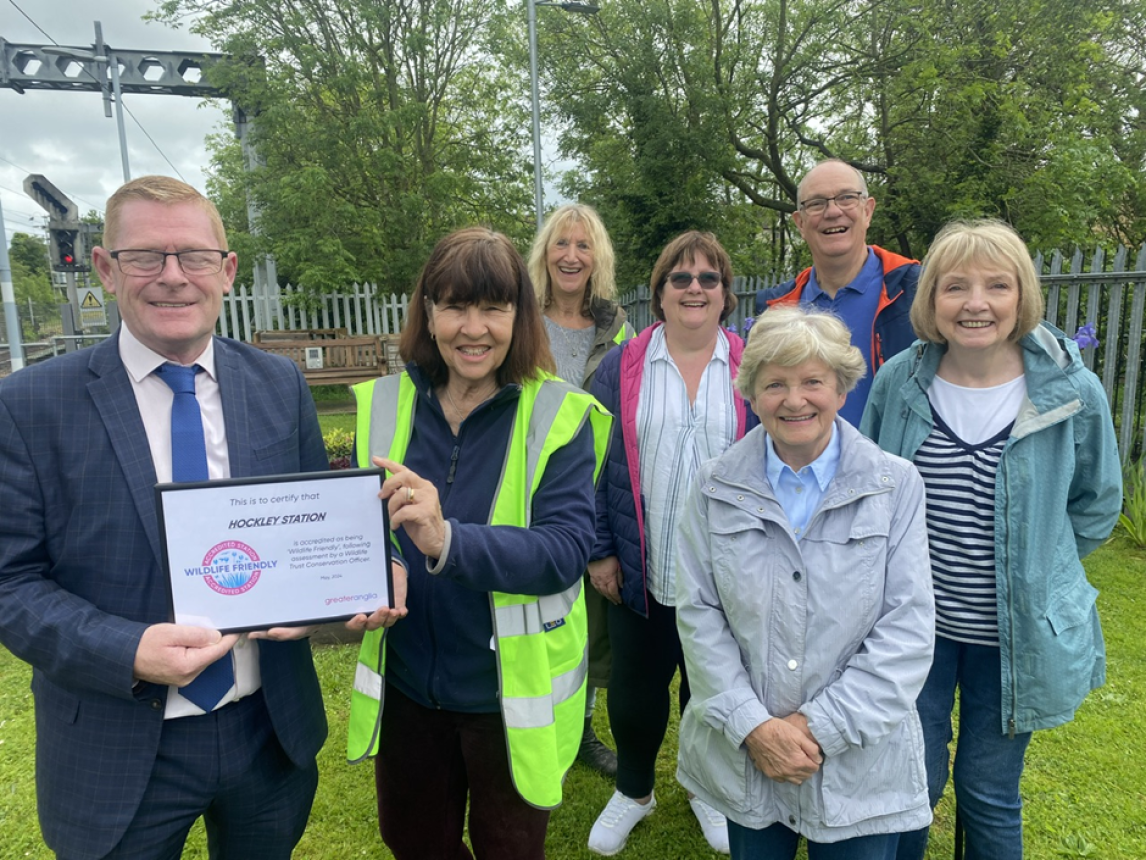Published on: Friday, 7 June 2024
Last updated: Friday, 7 June 2024
Above: Adopters at South Woodham Ferrers rail station with their Wildlife Friendly Stations accreditation. Credit: Greater Anglia
Three more Essex rail stations have received a ‘Wildlife Friendly’ accreditation recognising the work of community volunteers to improve biodiversity and support nature.
Greater Anglia has partnered with the region’s Wildlife Trusts to formally recognise the achievements of its teams of volunteer ‘station adopters’ to create wildlife havens at stations across its network, through the new ‘Greater Anglia Wildlife Friendly Stations Accreditation Scheme.’
Recently Hockley, Rayleigh and South Woodham Ferrers stations all received the accreditation, following assessment by an Essex Wildlife Trust Conservation Officer to determine how well the stations support local flora and fauna.
At Hockley, the station is looked after by a team of volunteers from the local U3A society who have been working to improve the station garden, incorporating more plants and an insect hotel.
Above: Adopters at Hockley rail station with their Wildlife Friendly Stations accreditation. Credit: Greater Anglia
Rayleigh’s station garden underwent redevelopment in 2022, transforming it into an area bursting with many different plants and flowers. It was noted in the ecologist’s report that the new garden was a good food source for insects, attracting a large number of pollinators such as butterflies.
Above: Adopters at Rayleigh rail station with their Wildlife Friendly Stations accreditation. Credit: Greater Anglia
At South Woodham Ferrers, the station adoption team have been working to improve the garden areas at the station with bee friendly plants and wildflowers and the installation of bird boxes and feeders.
Each assessment also offers tips and advice for how to make the stations more wildlife friendly and the reports can also be used as examples of best practice, to help spread good ideas around all Greater Anglia’s stations.
James Hogg, Development Officer at the Norfolk Wildlife Trust, the lead Trust for the initiative, said:
“The alarming decline in the abundance of wildlife and the plight of species under threat means that just protecting the nature we have left is not enough; we need to put nature into recovery, and to do so at scale and with urgency.
“This project with Greater Anglia is a fantastic example of how people can transform nature-poor areas into new nature-rich places – and change the way we think about land, seizing opportunities to help nature outside traditional nature reserves.”
Greater Anglia’s Customer and Community Engagement Manager, Alan Neville, said:
“We are delighted to partner with the region’s wildlife trusts to formally recognise the valuable work of our station adopter volunteers in supporting wildlife and improving their local environment.”
“I would like to congratulate the volunteer teams at Hockley, Rayleigh, and South Woodham Ferrers on receiving this recognition and thank them for the incredible work that they are doing that is helping to support biodiversity locally.”
Rail stations in East Anglia are increasingly becoming havens for local wildlife thanks to the efforts of over 300 volunteers who last year transformed over 9,000 square metres of land into thriving wildlife gardens.
In a recent survey, Greater Anglia station adopters reported a wide range of creatures visiting their stations, including many different types of butterflies as well as bees, slow worms, bats, foxes, toads, lizards, deer, and many varieties of birds.
Over the last 20 years, since the start of station adoption in East Anglia, the initiative has thrived, so that the vast majority of Greater Anglia stations now have station adopters. These ongoing increases in the areas adopted and the wildlife being seen on the stations show that the adopters are really playing their part in helping to make stations more biodiverse, as well as becoming more attractive gateways to the communities they serve.





